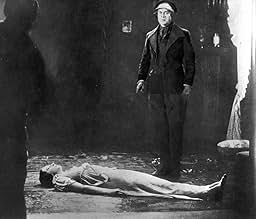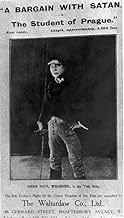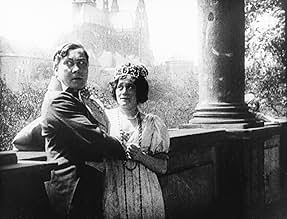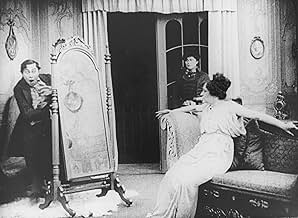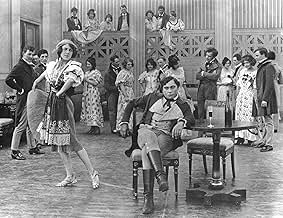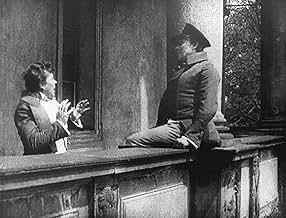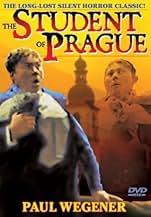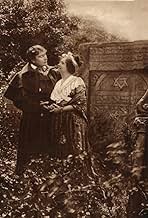Agrega una trama en tu idiomaThe poor student Balduin sells his mirror image to the satanic sorcerer Scapinelli. He falls in love with a countess and tries to win her over. But his mirror image receives a life of its' o... Leer todoThe poor student Balduin sells his mirror image to the satanic sorcerer Scapinelli. He falls in love with a countess and tries to win her over. But his mirror image receives a life of its' own and sabotages Balduin's every move.The poor student Balduin sells his mirror image to the satanic sorcerer Scapinelli. He falls in love with a countess and tries to win her over. But his mirror image receives a life of its' own and sabotages Balduin's every move.
- Dirección
- Guionistas
- Elenco
- Lyduschka, a Gypsy Girl
- (as L. Salmonowa)
- Self - with cap at Belvedere
- (sin créditos)
Opiniones destacadas
Unfortunately, the most cinematic this film gets is the double exposure effects to make Paul Wegener appear twice within scenes. Guido Seeber was a special effects wizard for his day, but he's not very good at positioning the camera or moving it. Film scholar Leon Hunt (printed in "Early Cinema: Space, Frame, Narrative"), however, has made an interesting analysis on this film using framing to amplify the doubles theme: characters being split by left/right, near/far and frontal/diagonal framing of characters and shots. Regardless, the film mostly consists of extended long shots from a fixed position, which is noticeably primitive. Worse is the lack of editing; there's very little scene dissection and scenes linger. None of this is unusual for 1913, but there were more advanced pictures in this respect around the same time, including the better parts of "Atlantis" (August Blom, 1913), "Twilight of a Woman's Soul" (Yevgeni Bauer, 1913) and the short films of D.W. Griffith.
An expanded universal film vocabulary by 1926 would allow for a superior remake. Furthermore, the remake has a reason for the Lyduschka character--other than being an occasional troublemaker and spectator surrogate. Here, the obtrusively acted gypsy lurks around, seemingly, with a cloak of invisibility. I know their world is silent to me, but I assume, with their lips moving and such, that their world would not be silent to them, so how can Lyduschka leer over others' shoulders and not be noticed?
Nevertheless, this is one of the most interesting early films conceptually. Wegener, who seems to have been the primary mind behind it, in addition to playing the lead, would later play the title role and co-direct "The Golem" in 1920--helping to further inaugurate a dark, supernatural thread in German silent cinema.
(Note: The first version I viewed was about an hour long (surely not quite complete) and was in poor condition, with faces bleached at times and such. I'm not sure who was the distributor. I've also since seen the Alpha DVD, which, at 41 minutes, is missing footage present in the aforementioned print and also has fewer and very different title cards, but is visually not as bad. The repetitive score is best muted, though.)
Based on Edgar Allen Poe's short story "William Wilson," "The Student of Prague" contains several expressionistic features. Its set lighting, especially in the card-playing sequence, where the actors are highlighted at the table while the background is completely dark, was unique in 1913. This contrasting light/dark Chiaroscuro lighting would become a trademark in future German Expressionism films.
Also, the story lends itself to an expressionistic idea: a financially struggling student unwittingly accepts money for what turns out to be a soulless Doppelgänger (a mirror image of lead actor Paul Wegener, the student). Cinematographer Guido Seeber was able to create the double image within a single frame seamlessly, using the special effects split screen to convince his audience the witnessing of a real spiritual being whose ultimate existence is to ruin the student's life.
The director, Stellan Rye, who died early in World War One (November 1914) in a prisoner of war camp, used the landmarks of Prague to make his fantasy tale more believable, another Expressionist imprint. Lastly, the German obsession with traits that are ripe for expressionistic examination, narcissism and greed leading to ultimate destruction, are all addressed here as well as future German classics such as "The Cabinet of Dr. Caligari (1921)," " Nosferatu (1922)," and "Metropolis (1927)."
Moving at a fast pace (the film runs just over an hour) and fairly well written and characterised, 'The Student of Prague' has echoes of the Faust legend as well as Dr Jekyll and Mr Hyde, starting as it does with a pact with a mysterious figure of potential evil, and developing into good and evil sides of the same person.
This is fairly primitive stuff, with an immobile camera, stage framing, and zero close-ups or medium shots. There are a number of basic doubling effects used for when Balduin and his evil twin are on screen together that surely wowed audiences of the day. The sets and costumes are fine. I'm not sure this would be of much interest to anyone outside of film historians, though, as it lacks any sense of pacing or even character beyond the most arbitrary.
¿Sabías que…?
- TriviaThis is sometimes considered to be the first horror film ever made.
- Citas
Balduin, a Student: Ruined am I! Procure for me the luckiest ticket in the lottery or a dowered wife.
- Versiones alternativasThere is an Italian edition of this film, included as Bonus Feature, on DVD "IL GOLEM" (1915), re-edited with the contribution of film historian Riccardo Cusin. This version is also available for streaming on some platforms.
- ConexionesFeatured in Fejezetek a film történetéböl: A német film 1933-ig (1989)
Selecciones populares
- How long is The Student of Prague?Con tecnología de Alexa
Detalles
- Fecha de lanzamiento
- País de origen
- Sitio oficial
- Idiomas
- También se conoce como
- The Student of Prague
- Locaciones de filmación
- Hradschin, Praga, República Checa(view of the castle and it's surroundings)
- Productora
- Ver más créditos de la compañía en IMDbPro
- Tiempo de ejecución1 hora 23 minutos
- Mezcla de sonido
- Relación de aspecto
- 4:3
- 1.33 : 1
Contribuir a esta página


